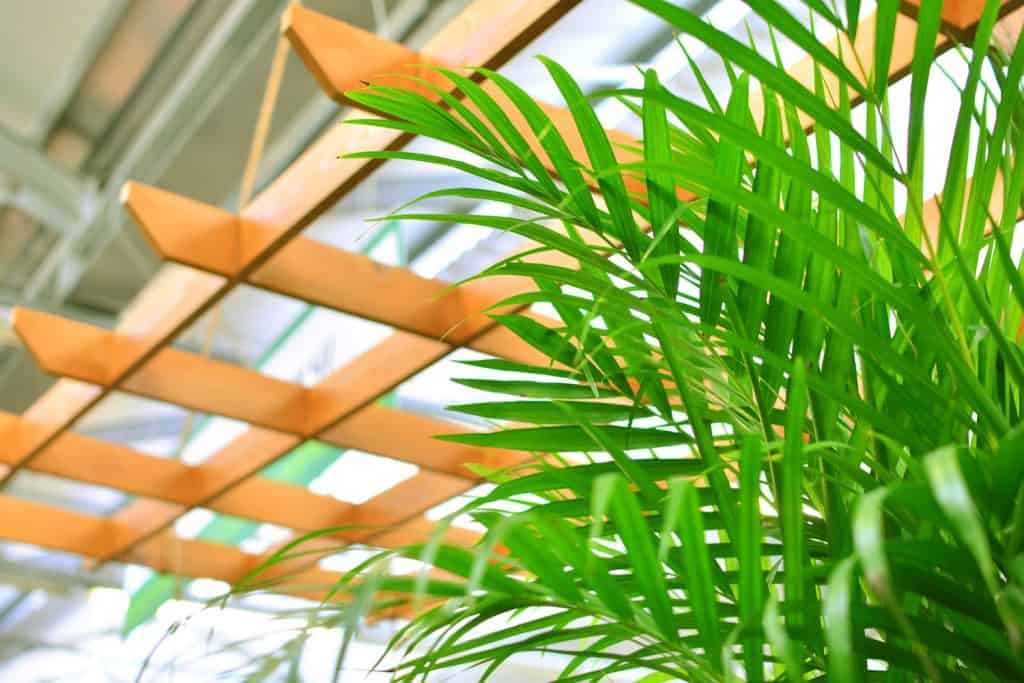While areca palm trees are fairly easy to grow, these beautiful indoor and outdoor plants have specific hydration requirements they need to be for them to thrive. But what are these requirements? And how can you tell if an areca palm is dying? We've researched the maintenance requirements for areca palms, and in this post, we will share them with you.
The biggest indicator that an areca palm tree is dying is when the fronds began to turn yellow, display brown tips, droop, or start to fall off the tree. The key to reviving a dying areca palm is to determine what's causing the increased stress level within the plant and then to remediate the issue as soon as possible. The sooner you tend to the issue, the better chance you will have at saving the plant.
Areca palm trees can be saved from dying if they are tended to properly. However, the plant must receive the right amount of sunlight and hydration so that it can repair itself. Continue reading to learn about how to prevent the areca palm from dying and how to mitigate the most common growing issues.

How do you save a dying areca palm?
How to revive your areca palm tree, you'll need to understand the conditions that have caused it to die. For example, if your tree has fronds that have turned yellow or brown, there could be an issue with humidity, hydration, or temperature. Or, if your tree has a soggy bark or branches, chances are that it has experienced root rot. The better you understand the underlying conditions for your dying tree, the faster you can get it back to life. Let's take a look at steps you can take to do this.

1. Remove any dead or decaying fronds
Take your pruning shears and cut off any brown or yellow fronds from the tree. Be sure not to rip them off the tree manually, but cut them off right at the trunk. You don't want to damage the tree's trunk during this process. Toss the dead leaves in a trash bag.
2. Re-pot the plant
If your areca palm tree has experienced root rot, you will need to replace the current soil in the pot. This means taking the plant out of the pot, removing most of the dirt from around the roots so that there is only a small root ball left, and then tossing the diseased soil in the trash bag. Next, place new fresh soil in the pot. Be sure to trim off any diseased roots from the bottom of the plant so that the healthy roots will grow into the soil.
3. Place the palm tree in an ideal location
Move the plant to a location where it can receive enough sunlight each day. However, if the frond tips are light brown and appear to have burns on their ends, the chances are that it was subjected to too much direct sunlight on a daily basis. You'll want to move the tree about four to eight feet away from sources of direct sunlight so that it can get the sun it needs without being burned. Indirect or filtered light is best for these trees.
4. Create the perfect environment
Be sure to monitor the daily temperature within the room to ensure that the tree is kept comfortable throughout the week. Most areca palm trees prefer a temperature anywhere between 75 to 85 degrees Fahrenheit during the day and anywhere from 60 to 65 degrees Fahrenheit at night. Keep in mind that these plants can tolerate temperatures between 50 and 55 degrees Fahrenheit during the night, but it's best to keep them a bit warmer.
Also, the ideal humidity for the areca palm trees anywhere from 40% to 50%. You can purchase a hygrometer to help monitor the humidity of the plant's environment.
Check out this hygrometer on Amazon.
5. Water the plant as needed
When reviving the areca palm, the initial amount of water required will depend on why it died. For example, if your plant suffered from root rot and diseased soil, it's best to refrain from watering the plant for about a week. However, if your plant died from dehydration, you'll want to add about one to two gallons of water to the soil to ensure that the roots have the hydration they need to grow larger.
Keep in mind that areca palms are very sensitive to becoming waterlogged and aren't the most forgiving tree when it comes to over-watering. Water the plant enough to wear the top half-inch of the soil is slightly moist, and you'll also want to be sure that the pot is well-draining so that the roots are not sitting in standing water. You can also use peat moss or perlite in your plant's topsoil to help improve drainage.
6. Inspect the plant for infestations
It's always a good idea to monitor the plant throughout the week to check for infestations. Pest infestations can quickly eat away at the plant's leaves and may eventually cause it to die. If you notice the leaves on your plant becoming yellow and starting to drop, it may be a sign of infestation. Other signs can include white spots or scales on the tips of the fronds that appear out of nowhere. To mitigate pest infestation issues, rub the plant leaves down with neem oil, alcohol, or rinse them in warm soapy water every two days for a week.
Learn more about this neem oil on Amazon.
Why is my areca palm drooping?
There are a few reasons why the leaves on the areca palm may start to droop. The most common reason is overwatering. If the leaves on your areca plant are drooping, take note of your watering regimen. Are you checking the soil before watering the plant each session? How much water or are you pouring into the soil? These plants respond sensitively to overwatering, and you'll notice that they will quickly turn yellow if and the leaves absorb too much water for several days.
Pest infestations can also cause droopy leaves. Closely inspect the leaves to look for any signs of mealybugs or spider mites. They will usually leave white, brown, or pink spots on the top of the portions of the leaves.
Why is my areca palm leaves turning yellow?

Overwatering
The most common reason why areca palm tree leaves may start to turn yellow is from overwatering. Keep in mind that these trees are fairly thirsty plants, so they will need weekly watering sessions to survive, especially in the summer months. However, you'll want to let the soil dry out a bit between waterings to prevent over-watering. If you notice the leaves on the tree beginning to turn yellow, it's best to immediately alter your water routine to prevent further damage to the leaves. The leaves will usually turn yellow before they turn brown if they are overwatered. And if the issue is not tended to, the leaves will eventually fall off.
Hard water
You'll also want to look at the type of water you use on your areca palm tree, as they can be a bit sensitive to minerals and salts. If you have a water softener in your sink, be sure to use it when watering your plants. Rainwater and distilled water are great for areca palm trees, as hard water can cause them to develop small mounds of salt and minerals on their topsoil. If hard water is the issue causing the yellowing, you may notice white mineral and salt deposits on the topsoil a week or so after you water the plant.
Spider Mites
Spider mites are also a common reason why the leaves may turn yellow on your areca palm tree. Though they can also become infected with mealybugs, spider mites are more common. If you notice any webbing on the plants or any speckled areas on the leaves, the chances are that there is a spider mite infestation. Oftentimes, you'll be able to rid the plant have these pests by simply misting the leaves with water, as dusty conditions can attract these bugs.
If misting doesn't work, consider using rubbing alcohol, insecticidal soaps, or rinse the plants in warm soapy water. You can do this every two to three days if needed, as some infestations can prove difficult to tackle.
Check out this insecticidal soap on Amazon.
Potassium Deficiency
Though not as common as overwatering in past issues, a protein potassium deficiency can also cause this tree to develop spotting or yellow areas on the leaves. The best way to mitigate this issue is to apply a potassium-rich fertilizer to the soil according to the directions on the package. Be sure that the amount of potassium is equal to the amount of nitrogen so that the plant has a perfect balance of both minerals.
Read more about this fertilizer on Amazon.
How do you keep areca palms from root rot?
The best way to keep areca Palm plants from developing root rot is to avoid watering the plant. Checking the soil for hydration before watering is absolutely crucial for this plant's survival. You'll also want to ensure that the plant receives enough sun throughout the day so that the soil has a chance to dry out before the next watering session.
Should I mist the areca palm?
Areca palm trees love moisture. Daily misting can definitely help keep the fronds of the areca palm tree hydrated. However, it's unnecessary if the plant's environment has a humidity level of 40% to 50% on a daily basis.
Can a dead palm tree come back to life?
Yes. You can bring a dead palm tree back to life by setting it up for success. The first thing you'll need to do is remove any dead leaves from the tree with a pair of pruning shears. Next, ensure that the plant's soil is healthy and that it has the perfect environment that it needs to grow.
This means creating an environment with the right temperature, humidity level, exposure to daily sunlight for the plant. The soil should be moist and well-draining. You can also add perlite, sand, and moss to help keep the soil heavy enough to support her plant but aerated enough to prevent waterlogs.
Wrapping Things Up
Areca palm trees are increasing in popularity, and this isn't dying down anytime soon. The most important takeaways are providing the plant with an adequate amount of sunlight daily and closely monitoring the amount of water that a plant receives, especially if it is a new plant.
Before you go, be sure to check out our other posts:




